大学英语等级考试听力耳机试音通知
- 格式:doc
- 大小:21.00 KB
- 文档页数:1

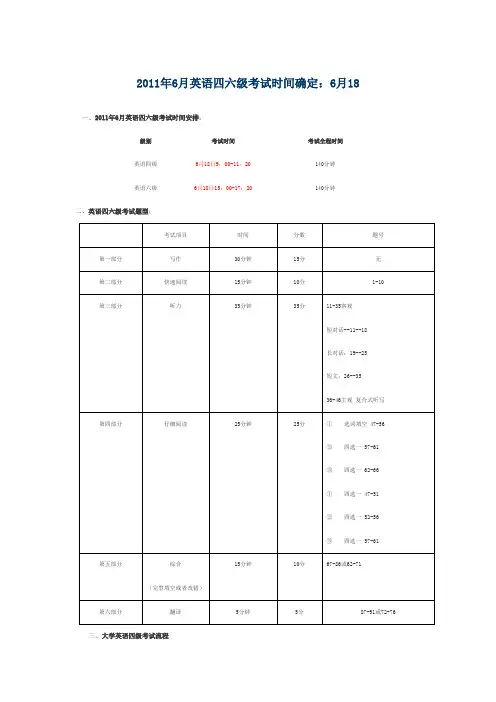
2011年6月英语四六级考试时间确定:6月18一、2011年6月英语四六级考试时间安排:级别考试时间考试全程时间英语四级6月18日9:00-11:20140分钟英语六级6月18日15:00-17:20140分钟二、英语四六级考试题型:考试项目时间分数题号第一部分写作30分钟15分无第二部分快速阅读15分钟10分1-10第三部分听力35分钟35分11-35客观短对话--11--18长对话:19--25短文:26--3536-46主观复合式听写第四部分仔细阅读25分钟25分①选词填空 47-56②四选一 57-61③四选一 62-66①四选一 47-51②四选一 52-56③四选一 57-61第五部分综合15分钟10分67-86或62-71(完型填空或者改错)第六部分翻译5分钟5分87-91或72-76三、大学英语四级考试流程8:50---9:00试音时间9:00---9:10播放考场指令,发放作文考卷9:10取下耳机,开始作文考试9:35发放含有快速阅读的试题册(但9:40才允许开始做) 9:40---9:55做快速阅读9:55---10:00收答题卡一(即作文和快速阅读)9:55---10:00重新戴上耳机,试音寻台,准备听力考试10:00开始听力考试,电台开始放音听力结束后完成剩余考项。
11:20全部考试结束。
四、大学英语六级考试流程14:50---15:00试音寻台时间15:00---15:10播放考场指令,发放作文考卷15:10取下耳机,开始作文考试15:35发放含有快速阅读的试题册(但15:40才允许开始做) 15:40---15:55做快速阅读部分15:55---16:00收答题卡一(即作文和快速阅读)15:55---16:00重新戴上耳机,试音寻台,准备听力考试16:00开始听力考试,电台开始放音听力结束后完成剩余考项。
17:20全部考试结束。
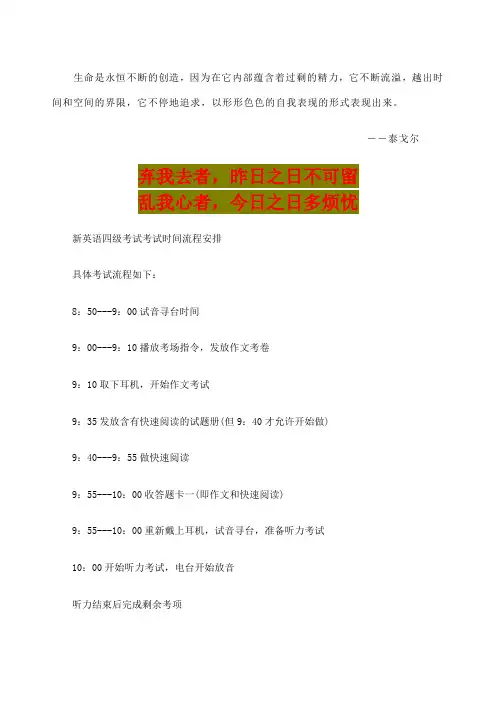
生命是永恒不断的创造,因为在它内部蕴含着过剩的精力,它不断流溢,越出时间和空间的界限,它不停地追求,以形形色色的自我表现的形式表现出来。
--泰戈尔弃我去者,昨日之日不可留乱我心者,今日之日多烦忧新英语四级考试考试时间流程安排具体考试流程如下:8:50---9:00试音寻台时间9:00---9:10播放考场指令,发放作文考卷9:10取下耳机,开始作文考试9:35发放含有快速阅读的试题册(但9:40才允许开始做)9:40---9:55做快速阅读9:55---10:00收答题卡一(即作文和快速阅读)9:55---10:00重新戴上耳机,试音寻台,准备听力考试10:00开始听力考试,电台开始放音听力结束后完成剩余考项11:20全部考试结束大学英语四级考试大纲Syllabus for College English Test—Band Four(CET-4)—总则国家教委在印发理工科本科和文理科本科用的两种《大学英语教学大纲》的通知中指出,大纲执行两年后,开始对结束四、六级学习的学生进行统一的标准化测试。
大学英语四级考试(CET-4)就是根据这一规定而设计的。
考试的目的在于全面考核已修完大学英语四级的学生是否达到教学大纲所确定的各项目标。
这种考试属于尺度相关常模参照性考试(criterion-related norm-referenced test)。
教学大纲指出:大学英语教学的目的是培养学生具有较强的阅读能力、一定的听的能力(理工科适用的大纲还规定一定的译的能力)以及初步的写和说的能力,使学生能以英语为工具,获取专业所需要的信息,并为进一步提高英语水平打下较好的基础。
为此,本考试主要考核学生运用语言的能力,同时也考核学生对语法结构和词语用法的掌握程度。
本考试是一种标准化考试。
由于目前尚不具备口试的条件,暂时只进行笔试。
考试范围主要是教学大纲所规定的一级至四级的全部内容(说与译的内容除外)。
为保证试卷的信度,除短文写作是主观性试题外,其余试题都采用客观性的多项选择题形式。
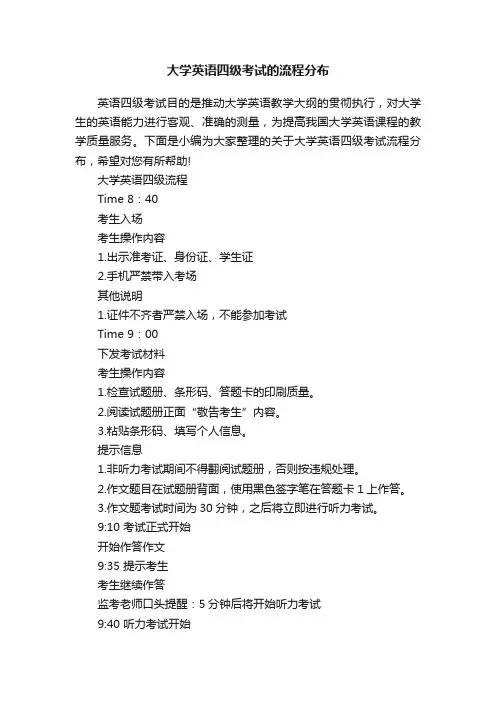
大学英语四级考试的流程分布英语四级考试目的是推动大学英语教学大纲的贯彻执行,对大学生的英语能力进行客观、准确的测量,为提高我国大学英语课程的教学质量服务。
下面是小编为大家整理的关于大学英语四级考试流程分布,希望对您有所帮助!大学英语四级流程Time 8:40考生入场考生操作内容1.出示准考证、身份证、学生证2.手机严禁带入考场其他说明1.证件不齐者严禁入场,不能参加考试Time 9:00下发考试材料考生操作内容1.检查试题册、条形码、答题卡的印刷质量。
2.阅读试题册正面“敬告考生”内容。
3.粘贴条形码、填写个人信息。
提示信息1.非听力考试期间不得翻阅试题册,否则按违规处理。
2.作文题目在试题册背面,使用黑色签字笔在答题卡1上作答。
3.作文题考试时间为30分钟,之后将立即进行听力考试。
9:10 考试正式开始开始作答作文9:35 提示考生考生继续作答监考老师口头提醒:5分钟后将开始听力考试9:40 听力考试开始请考生掌握好答题卡1的填涂时间,听力录音播放完毕后,将立即回收答题卡1听力理解30分钟10:05 听力考试结束停止作答,摘下耳机回收答题卡1考试暂停五分钟,等待收答题卡10:10 命令考生继续作答作答阅读理解和翻译部分11:10 提示考生继续作答,掌握好时间10分钟后考试结束监考老师口头提醒Time 11:20考试结束考生操作内容1.考生停止作答2.考生交回试题册、答题卡2提示信息老师清点无误后考生方可离场大学英语四级考试流程8:50---9:00试音时间9:00---9:10播放考场指令,发放作文考卷9:10取下耳机,开始作文考试9:35发放含有快速阅读的试题册(但9:40才允许开始做)9:40---9:55做快速阅读9:55---10:00收答题卡一(即作文和快速阅读)9:55---10:00重新戴上耳机,试音寻台,准备听力考试10:00开始听力考试,电台开始放音听力结束后完成剩余考项。
11:20全部考试结束。
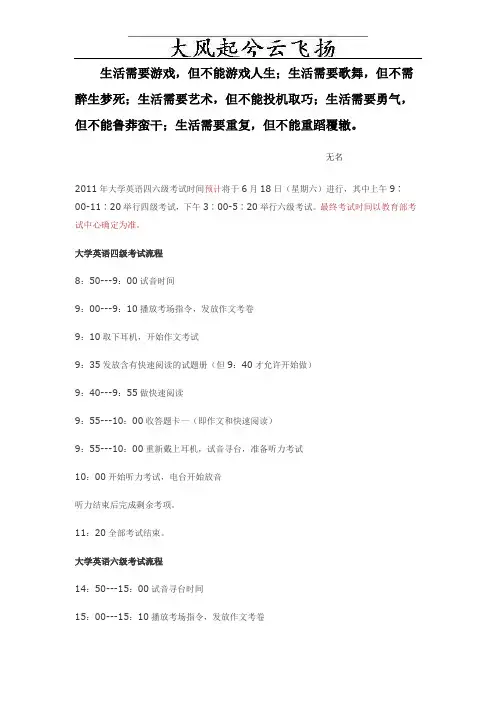
生活需要游戏,但不能游戏人生;生活需要歌舞,但不需醉生梦死;生活需要艺术,但不能投机取巧;生活需要勇气,但不能鲁莽蛮干;生活需要重复,但不能重蹈覆辙。
-----无名
2011年大学英语四六级考试时间预计将于6月18日(星期六)进行,其中上午9∶00-11∶20举行四级考试,下午3∶00-5∶20举行六级考试。
最终考试时间以教育部考试中心确定为准。
大学英语四级考试流程
8:50---9:00试音时间
9:00---9:10播放考场指令,发放作文考卷
9:10取下耳机,开始作文考试
9:35发放含有快速阅读的试题册(但9:40才允许开始做)
9:40---9:55做快速阅读
9:55---10:00收答题卡一(即作文和快速阅读)
9:55---10:00重新戴上耳机,试音寻台,准备听力考试
10:00开始听力考试,电台开始放音
听力结束后完成剩余考项。
11:20全部考试结束。
大学英语六级考试流程
14:50---15:00试音寻台时间
15:00---15:10播放考场指令,发放作文考卷
15:10取下耳机,开始作文考试
15:35发放含有快速阅读的试题册(但15:40才允许开始做)15:40---15:55做快速阅读部分
15:55---16:00收答题卡一(即作文和快速阅读)
15:55---16:00重新戴上耳机,试音寻台,准备听力考试16:00开始听力考试,电台开始放音
听力结束后完成剩余考项。
17:20全部考试结束。
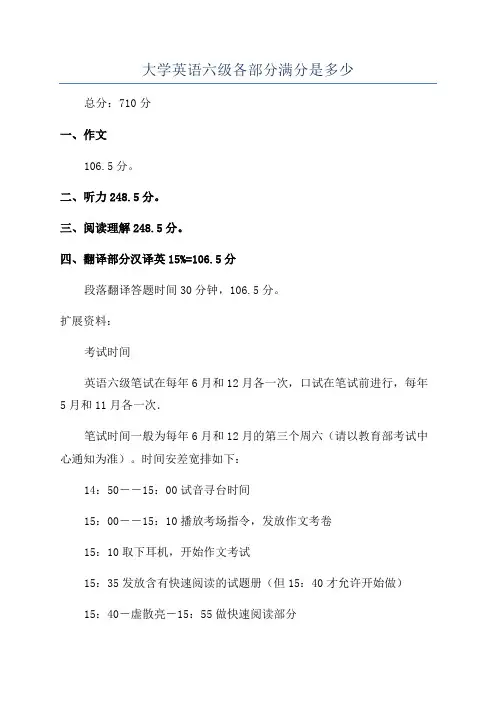
大学英语六级各部分满分是多少
总分:710分
一、作文
106.5分。
二、听力248.5分。
三、阅读理解248.5分。
四、翻译部分汉译英15%=106.5分
段落翻译答题时间30分钟,106.5分。
扩展资料:
考试时间
英语六级笔试在每年6月和12月各一次,口试在笔试前进行,每年5月和11月各一次.
笔试时间一般为每年6月和12月的第三个周六(请以教育部考试中心通知为准)。
时间安差宽排如下:
14:50--15:00试音寻台时间
15:00--15:10播放考场指令,发放作文考卷
15:10取下耳机,开始作文考试
15:35发放含有快速阅读的试题册(但15:40才允许开始做)
15:40-虚散亮-15:55做快速阅读部分
15:55--16:00收答题卡一(即作文和快速阅读)
15:55--16:00重新戴上耳机,试音寻台,准备听力考试
16:00开始听力考试,电台开始放音
听力结束后完成剩余考项。
17:20全部考试结束
报名
全国大学英语六级考试的主要对象是高等学校修完大学英语四级的本科生;同等程度的大专生或硕士研究掘斗生经所在学校同意,可在本校报名参加考试;同等程度的夜大或函授大学学生经所在学校同意,可在本校报名参加考试。

2013年6月英语四六级成绩查询为了广大学员能够更好的备考2013年英语四级考试,好学教育编辑为您搜集整理了2013年6月英语四级成绩查询时间通知,以及最新的2013年英语四级考试资讯和辅导资料,希望对各位考生有所帮助,建议将本站加入收藏。
好学教育祝您顺利通过考试!关于2013年6月全国大学英语四、六级考试成绩发布时间的通知一、关于“多题多卷”考试模式的说明大学英语四、六级考试自1987年开始实施以来各次考试的报道成绩都经过等值处理,使得历次考试报道成绩具有可比性,从而确保了考试的公平性。
2012年12月考试开始采用“多题多卷”模式实施考试。
“多题多卷”指在同一考场内采用内容不同的试题组成的多套试卷实施考试。
多套试卷之间的难度差异对考生成绩的影响通过试卷之间的等值计算来得到平衡,因此考生的报道成绩不会因其所答试卷的不同而受影响。
二、2013年6月考试成绩发布的相关事宜2013年6月全国大学英语四、六级考试成绩将于2013年8月21日上午9点发布。
成绩查询方式网上免费查分:/IhElnD2013年CET考试时间及流程2013年英语六级考试分为上下半年,分别是6月份和12月份。
根据2013年福建省教育考试院考试历:2013年英语六级考试时间分别为:6月15日和12月14日。
2013年CET考试时间(一)上半年1.CET4:6月15日上午:09:00—11:202.CET6:6月15日下午:15:00—17:20(二)下半年1.CET4: 12月14日上午:09:00—11:202.CET6:12月14日下午:15:00—17:20根据>>2013年全国大学英语四、六级网考计划,大学英语六级网考试点考试时间安排如下:2013年4月13日14:00至16:002013年5月25日14:00至16:002013年10月26日14:00至16:002013年11月23日14:00至16:0014:50——15:00试音寻台时间15:00——15:10播放考场指令,发放作文考卷15:10取下耳机,开始作文考试15:35发放含有快速阅读的试题册(但15:40才允许开始做)15:40——15:55做快速阅读部分15:55——16:00收答题卡一(即作文和快速阅读)15:55——16:00重新戴上耳机,试音寻台,准备听力考试16:00开始听力考试,电台开始放音听力结束后完成剩余考项。

考试简介概述全国大学英语等级考试是教育部主管的一项全国性的教学考试,其目大学英语四级考试答题卡(4张)的是对大学生的实际英语能力进行客观、准确的测量,为大学英语教学提供服务。
大学英语考试也是一项大规模标准化考试,在设计上必须满足教育测量理论对大规模标准化考试的质量要求,是一个“标准关联的常模参照测验”。
教育部也在完善考试模式,力求建立现代信息技术条件下大学英语四、六级考试新模式,全面实现考试管理信息化。
大学英语考试根据理工科本科和文理科本科用的两个《大学英语教学大纲》,由教育部(原国家教育委员会)高等教育司组织的全国统一的单科性标准化教学考试,分大学英语四级考试(CET-4)和大学英语六级考试(CET-6)两种。
每年考试过后8月份或9月份公布成绩并颁发成绩单,根据教育部规定四六级考试不设置及格线,四级425分以上可以报考六级,所以大家普遍认为四六级的合格线为425分。
报名时间CET全国英语四六级考试的报名时间为:每年3月份、9月份(每年时间略有不同)。
考试日期大学英语四级全套样卷(29张)2013年考试时间为:通常情况下为每年6月份、12月份的第三个星期六。
2012年12月比较特殊,为第四个星期六,22日2013年12月考试时间预计是2013年12月14日。
[1]考试流程8:50---9:00试音时间9:00---9:10播放考场指令,发放作文考卷9:10取下耳机,开始作文考试9:35发放含有快速阅读的试题册(9:40才允许开始做)9:40---9:55做快速阅读9:55---10:00收答题卡一(即作文和快速阅读)9:55---10:00重新戴上耳机,试音寻台,准备听力考试10:00开始听力考试,电台开始放音听力结束后完成剩余考项。
11:20全部考试结束。
成绩公布根据往年全国大学英语四、六级考试成绩公布时间间隔,一般成绩会在考试结束后的66天左右公布。
成绩查询大学英语四级和六级成绩查询方式:考生可以通过网上免费查分和收费短信查分两种方式进行。
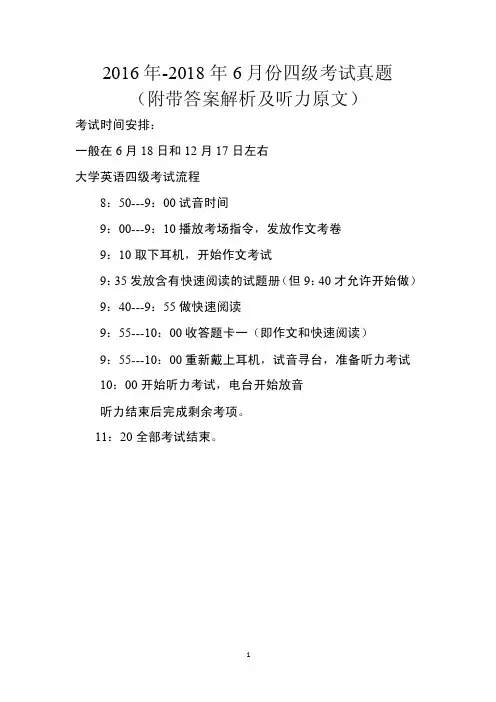
2016年-2018年6月份四级考试真题(附带答案解析及听力原文)考试时间安排:一般在6月18日和12月17日左右大学英语四级考试流程8:50---9:00试音时间9:00---9:10播放考场指令,发放作文考卷9:10取下耳机,开始作文考试9:35发放含有快速阅读的试题册(但9:40才允许开始做)9:40---9:55做快速阅读9:55---10:00收答题卡一(即作文和快速阅读)9:55---10:00重新戴上耳机,试音寻台,准备听力考试10:00开始听力考试,电台开始放音听力结束后完成剩余考项。
11:20全部考试结束。
Part ⅠWriting (30minutes)Directions: For this part, you are allowed 30 minutes to write a short essay entitled Excessive Packaging following the outline given below. You should write at least 120 words but no more than 180 words.1.目前许多商品存在过度包装的现象2.出现这一现象的原因3.我对这一现象的看法和建议On Excessive PackagingPart Ⅱ Reading Comprehension(Skimming and Scanning)(15minutes)Directions: In this part, you will have 15 minutes to go over the passage quickly and answer the questions on Answer sheet 1. For questions 1-7,choose the best answer from the four choices marked A),B),C)and D). For questions 8-10,complete the sentences with the information given in the passage.Small Schools RisingTh is year‟s list of the top 100 high schools shows that today, those with fewer students are flourishing.Fifty years ago, they were the latest thing in educational reform: big, modern, suburban high schools with students counted in the thousands. As baby boomers(二战后婴儿潮时期出生的人) came of high-school age, big schools promised economic efficiency. A greater choice of courses, and, of course, better football teams. Only years later did we understand the trade-offs this involved: the creation of excessive bureaucracies(官僚机构),the difficulty of forging personal connections between teachers and students.SAT scores began dropping in 1963;today,on average,30% of students do not complete high school in four years, a figure that rises to 50% in poor urban neighborhoods. While the emphasis on teaching to higher, test-driven standards as set in No Child Left Behind resulted in significantly better performance in elementary(and some middle)schools, high schools for a variety of reasons seemed to have made little progress.S ize isn‟t everything, but it does matter, and the past decade has seen a noticeable countertrend toward smaller schools. This has been due ,in part ,to the Bill and Melinda Gates Foundation, which has invested $1.8 billion in American high schools, helping to open about1,000 small schools-most of them with about 400 kids each with an average enrollment of only150 per grade, About 500 more are on the drawing board. Districts all over the country are taking notice, along with mayors in cities like New York, Chicago and San Diego. The movement includes independent public charter schools, such as No.1 BASIS in Tucson, with only 120high-schoolers and 18 graduates this year. It embraces district-sanctioned magnet schools, such as the Talented and Gifted School, with 198 students, and the Science and EngineeringMagnet,with383,which share a building in Dallas, as well as the City Honors School in Buffalo, N.Y., which grew out of volunteer evening seminars for students. And it includes alternative schools with students selected by lottery(抽签),such as H-B Woodlawn in Arlington, Va. And most noticeable of all, there is the phenomenon of large urban and suburban high schools thathave split up into smaller units of a few hundred, generally housed in the same grounds that once boasted thousands of students all marching to the same band.Hillsdale High School in San Mateo, Calif, is one of those, ranking No.423—among the top 2% in the country—on Newsweek‟s annual ranking of America‟s top high schools. The success of small schools is apparent in the listings. Ten years ago, when the first Newsweek list based on college-level test participation was published, only three of the top 100 schools had graduating Classes smaller than 100 students. This year there are 22. Nearly 250 schools on thefull ,Newsweek list of the top 5% of schools nationally had fewer than 200 graduates in 2007.Although many of Hillsdale‟s students came from wealthy households, by the late 1990 average test scores were sliding and it had earned the unaffectionate nickname (绰号) “Hillsjail. ” Jeff Gilbert. A Hillsdale teacher who became principal last year, remembers sitting with other teachers watching students file out of a graduation ceremony and asking one another in astonishment, “How did that student graduate?”So in 2003 Hillsdale remade itself into three “houses,” romantically named Florence, Marrakech and Kyoto. Each of the 300 arriving ninth graders are randomly(随机地) assigned to one of the houses. Where they will keep the same four core subject teachers for two years, before moving on to another for 11th and 12t h grades. The closeness this system cultivates is reinforcedby the institution of “advisory” classes Teachers meet with students in groups of 25, five mornings a week, for open-ended discussions of everything from homework problems to bad Saturday-night dates. The advisers also meet with students privately and stay in touch with parents, so they are deeply invested in the students‟ success.“We‟re constantly talking about one another‟s advisers,” says English teacher Chris Crockett. “If you hear that yours isn‟t doing well in math, or see them sitting outside the dean‟s office, it‟s like a personal failure.” Along with the new structure came a more demanding academic program, the percentage of freshmen taking biology jumped from 17 to 95.“It was rough for some. But by senior year, two-thirds have moved up to physics,” says Gilbert “Our kids are coming to school in part because they know there are adults here who know themand care for th em.”But not all schools show advances after downsizing, and it remains to be seen whether smaller schools will be a cure-all solution.The Newsweek list of top U.S. high schools was made this year, as in years past, according to a single metric, the proportion of students taking college-level exams. Over the years this system has come in for its share of criticism for its simplicity. But that is also its strength: it‟s easy for readers to understand, and to do the arithmetic for their own schools if they‟d like.Ranking schools is always controversial, and this year a group of 38 superintendents(地区教育主管)from five states wrote to ask that their schools be excluded from the calculation.“It is impossible to know which high schools are …the best‟ in the nation, ”their letter read. in part. “Determining whether different schools do or don‟t offer a high quality of education requires a look at man different measures, including students‟ overall academic accomplishments and their subsequent performance in college. And taking into consideration the unique needs of their communities.”In the end, the superintendents agreed to provide the data we sought, which is, after all, public information. There is, in our view, no real dispute here, we are all seeking the same thing, which is schools that better serve our children and our nation by encouraging students to tackle tough subjects under the guidance of gifted teachers. And if we keep working toward that goal, someday, perhaps a list won‟t be necessary.注意:此部分试题请在答卡1上作答.1.Fifty years ago. big. Modern. Suburban high schools were established in the hope of __________.A) ensuring no child is left behindB) increasing economic efficiencyC) improving students‟ performance on SATD)providing good education for baby boomers2. What happened as a result of setting up big schools?A)Teachers‟ workload increased.B)Students‟ performance declined.C)Administration became centralized.D)Students focused more on test scores.3.What is said about the schools forded by the Bill and Melinda Gates foundation?A)They are usually magnet schools.B)They are often located in poor neighborhoods.C)They are popular with high-achieving students.D)They are mostly small in size.4.What is most noticeable about the current trend in high school education?A)Some large schools have split up into smaller ones.B)A great variety of schools have sprung up in urban and suburban areas.C)Many schools compete for the Bill and Melinda Gates Foundation funds.D)Students have to meet higher academic standards.5.Newsweek ranked high schools according to .A)their students‟ academic achievementB)the number of their students admitted to collegeC)the size and number of their graduating classesD)their college-level test participation6.What can we learn about Hillsdale‟s students in the late 1990s?A)They were made to study hard like prisoners.B)They called each other by unaffectionate nicknames.C)Most of them did not have any sense of discipline,D)Their school performance was getting worse.7.According to Jeff Gilbert, the “advisory” classes at Hillsdale were set up so that students could .A)tell their teachers what they did on weekendsB)experience a great deal of pleasure in learningC)maintain closer relationships with their teachersD)tackle the demanding biology and physics courses8. is still considered a strength of Newsweek‟s school ranking system in spite of the criticism it receives.9.According to the 38 superintendents, to rank schools scientifically, it is necessary to use .10.To better serve the children and our nation, schools students to take .Part Ⅲ Listening Comprehension (35minutes)Section ADirections: in this section you will hear 8 short conversations, one or more questions will be asked about what was said. Both the conversation and the questions will be spoken only once. After each question there will be a pause. During the pause, you must read the four choices marked A)、B)、C)and D)、and decide which is the best answer. Then mark the corresponding letter on Answer sheet 2 with a single line through the centre.注意:此部分试题请在答案卡2上作案。
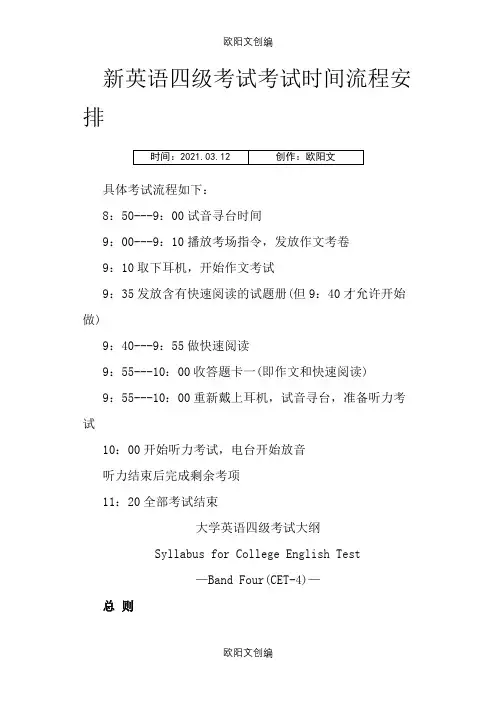
新英语四级考试考试时间流程安排具体考试流程如下:8:50---9:00试音寻台时间9:00---9:10播放考场指令,发放作文考卷9:10取下耳机,开始作文考试9:35发放含有快速阅读的试题册(但9:40才允许开始做)9:40---9:55做快速阅读9:55---10:00收答题卡一(即作文和快速阅读)9:55---10:00重新戴上耳机,试音寻台,准备听力考试10:00开始听力考试,电台开始放音听力结束后完成剩余考项11:20全部考试结束大学英语四级考试大纲Syllabus for College English Test—Band Four(CET-4)—总则国家教委在印发理工科本科和文理科本科用的两种《大学英语教学大纲》的通知中指出,大纲执行两年后,开始对结束四、六级学习的学生进行统一的标准化测试。
大学英语四级考试(CET-4)就是根据这一规定而设计的。
考试的目的在于全面考核已修完大学英语四级的学生是否达到教学大纲所确定的各项目标。
这种考试属于尺度相关常模参照性考试(criterion-related norm-referenced test)。
教学大纲指出:大学英语教学的目的是培养学生具有较强的阅读能力、一定的听的能力(理工科适用的大纲还规定一定的译的能力)以及初步的写和说的能力,使学生能以英语为工具,获取专业所需要的信息,并为进一步提高英语水平打下较好的基础。
为此,本考试主要考核学生运用语言的能力,同时也考核学生对语法结构和词语用法的掌握程度。
本考试是一种标准化考试。
由于目前尚不具备口试的条件,暂时只进行笔试。
考试范围主要是教学大纲所规定的一级至四级的全部内容(说与译的内容除外)。
为保证试卷的信度,除短文写作是主观性试题外,其余试题都采用客观性的多项选择题形式。
短文写作部分旨在较好地考核学生运用语言的能力,从而提高试卷的效度。
本考试于每学期结束前后举行,由大学英语四、六级标准考试设计组负责和实施。
大学英语等级考试听力耳机试音通知
1.试音时间:2010年6月18日上午9:45—下午14:25。
2.试音内容:
①综合楼考区、服装学院考区:用调频76.9兆赫,给CET4、6级和A级、B
级考生反复播放“大连工业大学外语发射一台调频76.9兆赫听力考试正在
试音”。
②研究生院考区:用调频74.8兆赫,给CET4考生反复播放“大连工业大学
外语发射二台调频74.8兆赫听力考试正在试音”。
3.耳机波段:06、07、08和09级在校学生发的耳机波段开关应拨到FM2。
4.耳机调试:考生应在规定的时间内,将无线耳机装入两节电量充足5号
电池。在试音过程中考生如果发现耳机有问题,可以向不参加考试的同学借用
一下(或自备30元钱在18号之前到综C219录音室购买);06、07、08和09级
学生发下的耳机都有液晶频率显示,请考生到时候注意核对接收频率。
5.注意事项:考生本人应亲自到考场和指定座位进行耳机调试,并注意接
收效果;若效果不好,更换新的电池和抽出耳机天线,能够增强接收效果。如
耳机正常,上述方法使用后还有其它异常情况,请及时与教务处考务中心取得
联系。未按时试音而影响听力部分考试的责任由考生本人负责。
本次所有级别的英语考试在考场内监考教师均不给配置外语考试专用收音
机,请考生务必自带无线耳机!
6.特别提示:英语四级听力考试是在6月19日上午10:00开始播放,上
午8:30—9:00第一次试音(9:55第二次试音准备);英语六级听力考试是在
下午14:30—15:00第一次试音(15:55第二次试音准备),下午16:00播放
六级听力考试的录音带。
教 务 处
外国语学院
2010年6月9日